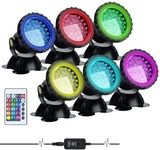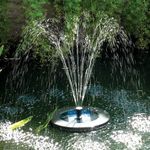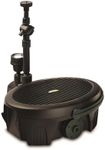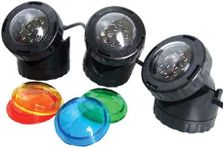Buying Guide for the Best Led Pond Lights
Choosing the right LED pond lights can transform your pond into a beautiful nighttime feature. When selecting LED pond lights, it's important to consider several key specifications to ensure you get the best fit for your needs. These specifications will help you determine the brightness, color, durability, and overall functionality of the lights. Understanding these specs will guide you in making an informed decision that enhances the aesthetic appeal and safety of your pond.Brightness (Lumens)Brightness, measured in lumens, indicates how much light the LED pond light emits. This is important because it affects how well the pond and its features are illuminated. Lower lumens (around 100-200) are suitable for subtle, ambient lighting, while higher lumens (300-600) are better for highlighting specific features or providing more visibility. Choose the brightness level based on whether you want a soft glow or a more pronounced illumination.
Color TemperatureColor temperature, measured in Kelvins (K), describes the color of the light emitted. This is important for setting the mood and aesthetic of your pond. Lower color temperatures (2000K-3000K) produce a warm, yellowish light, ideal for creating a cozy and inviting atmosphere. Higher color temperatures (5000K-6500K) emit a cool, bluish light, which can make the pond look more vibrant and modern. Decide on the color temperature based on the ambiance you wish to create.
Waterproof Rating (IP Rating)The waterproof rating, indicated by an IP (Ingress Protection) code, shows how well the lights are protected against water and dust. This is crucial for ensuring the lights can withstand being submerged and exposed to the elements. An IP68 rating is ideal for pond lights as it means the lights are fully waterproof and can be submerged in water for extended periods. Ensure the lights have a high IP rating to guarantee durability and safety.
Power SourceLED pond lights can be powered by electricity, solar energy, or batteries. This is important for convenience and energy efficiency. Electric-powered lights are reliable and provide consistent brightness but require a power source nearby. Solar-powered lights are eco-friendly and cost-effective but depend on sunlight for charging. Battery-powered lights offer flexibility in placement but need regular battery replacements. Choose the power source based on your pond's setup and your preference for maintenance.
Adjustability and ControlAdjustability and control features, such as remote controls, timers, and color-changing options, enhance the functionality of LED pond lights. These features are important for customizing the lighting to suit different occasions and moods. Lights with remote controls and timers allow for easy operation and scheduling, while color-changing lights offer versatility in creating various lighting effects. Consider these features if you want more control over your pond's lighting.
Installation and Mounting OptionsInstallation and mounting options determine how and where the lights can be placed in your pond. This is important for achieving the desired lighting effect and ease of setup. Some lights come with stakes for easy placement in the ground, while others have mounts for attaching to surfaces. Floating lights are also an option for a unique look. Choose the installation type that best fits your pond's layout and your preference for ease of installation.











